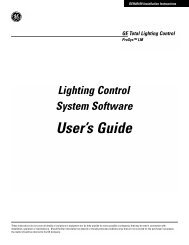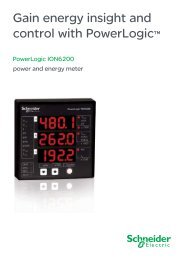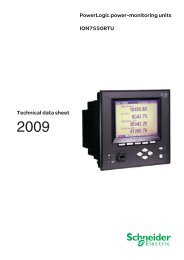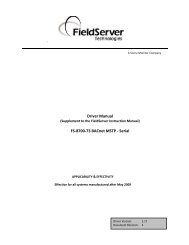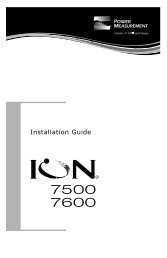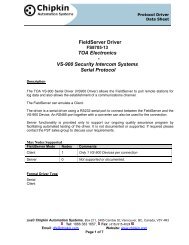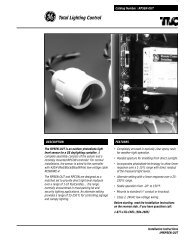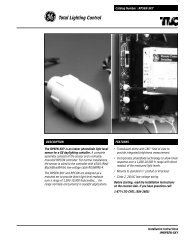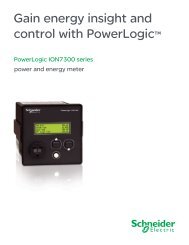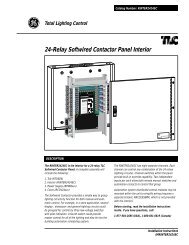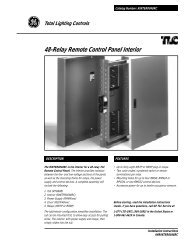Modbus Protocol for ION 7500, ION 7600 and ION 8000 series
Modbus Protocol for ION 7500, ION 7600 and ION 8000 series
Modbus Protocol for ION 7500, ION 7600 and ION 8000 series
- No tags were found...
You also want an ePaper? Increase the reach of your titles
YUMPU automatically turns print PDFs into web optimized ePapers that Google loves.
<strong>7500</strong>, <strong>7600</strong> <strong>and</strong><strong>8000</strong> Series MeterAdvanced Digital Power /Instrumentation PackageModicon <strong>Modbus</strong>Serial Communications <strong>Protocol</strong>Version 0.8
Limitation of LiabilityFor further assistanceplease contact us at:Worldwide Headquarters2195 Keating Cross RoadSaanichton, BCCanada V8M 2A5Tel: 1-250-652-7100Fax: 1-250-652-0411Email:support@pwrm.comwww.pwrm.com© 2003 Power MeasurementPrinted in CanadaRevision Date: June 5, 200370020-0114-08Power Measurement Ltd. (“Power Measurement”) reserves the right to make changes in thedevice or its specifications identified in this document without notice. Power Measurementadvises customers to obtain the latest version of the device specifications be<strong>for</strong>e placingorders to verify that the in<strong>for</strong>mation being relied upon by the customer is current.Regardless of whether any remedy set <strong>for</strong>th herein fails of its essential purpose, except tothe extent the following limitation is prohibited by applicable law, Power Measurementshall not, in any event or under any legal claim or theory (whether based on contract,indemnity, warranty, tort (including negligence <strong>and</strong> strict liability) or otherwise), beliable to the original purchaser or any other person or entity <strong>for</strong> special, indirect,incidental, punitive, liquidated, special or consequential damages whatsoever withrespect to any purchased product, including, without limitation, business interruption,loss of use, profit or revenue, even if Power Measurement has been advised of thepossibility of such damages. To the extent that a limitation or exclusion of consequentialdamages are prohibited by applicable law, then Power Measurement’s liability shall belimited to twice the amount of the relevant purchased product. Not to limit the <strong>for</strong>egoing,a) Power Measurement shall not be liable <strong>for</strong> any claim (other than a claim solely <strong>for</strong> thebreach of one of the warranties as outlined in the Terms <strong>and</strong> Conditions of Sale(“Warranties”)) made by the original purchaser, its employees, agents, or contractors <strong>for</strong>any loss, damage, or expense incurred due to, caused by, or related to any purchasedproduct; <strong>and</strong> b) the Warranties are the original purchaser's exclusive remedy <strong>and</strong> PowerMeasurement hereby expressly disclaims all other warranties, express or implied,including, without limitation, warranties of non-infringement <strong>and</strong> the impliedwarranties of merchantability <strong>and</strong> fitness <strong>for</strong> a particular purpose.The Warranties shall not apply to any product that has been subject to alteration, accident,misuse, abuse, neglect or failure to exactly follow Power Measurement's instructions <strong>for</strong>operation <strong>and</strong> maintenance. Any technical assistance provided by Power Measurement'spersonnel or representatives in system design shall be deemed to be a proposal <strong>and</strong> not arecommendation. The responsibility <strong>for</strong> determining the feasibility of such proposals restswith the original purchaser <strong>and</strong> should be tested by the original purchaser. It is the originalpurchaser’s responsibility to determine the suitability of any product <strong>and</strong> associateddocumentation <strong>for</strong> its purposes. The original purchaser acknowledges that 100% "up" timeis not realizable because of possible hardware or software defects. The original purchaserrecognizes that such defects <strong>and</strong> failures may cause inaccuracies or malfunctions. Only theterms expressed in the Warranties shall apply <strong>and</strong> no distributor, corporation or otherentity, individual or employee of Power Measurement or any other entity is authorized toamend, modify or extend the Warranties in any way.For more in<strong>for</strong>mation, refer to the Terms <strong>and</strong> Conditions of Sale document on our websiteat: http://www.pwrm.com/Buy/The in<strong>for</strong>mation contained in this document is believed to be accurate at the time ofpublication, however, Power Measurement assumes no responsibility <strong>for</strong> any errors whichmay appear here <strong>and</strong> reserves the right to make changes without notice.<strong>ION</strong>, <strong>ION</strong> Enterprise, <strong>ION</strong> Meter Shop, <strong>ION</strong> Setup, <strong>ION</strong> Wire, <strong>ION</strong> Reader, PEGASYS,PowerView, <strong>ION</strong> 6200, <strong>ION</strong> 7300, <strong>ION</strong> 7330, <strong>ION</strong> 7350, <strong>ION</strong> <strong>7500</strong>, <strong>ION</strong> <strong>7600</strong>, <strong>ION</strong> 7700, <strong>ION</strong>8300, <strong>ION</strong> 8400, <strong>ION</strong> 8500, COM32, COM128, Vista, VIP, Designer, Reporter, MeterM@il,WebMeter, EtherGate, ModemGate, Xpress Card, Feature Packs <strong>and</strong> “smart energyeverywhere” are either registered trademarks or trademarks of Power Measurement. Allother trademarks are property of their respective owners.Covered by one or more of the following patents:U.S. Patent No's 6397155, 6186842, 6185508, 6000034, 5995911, 5828576, 5736847, 5650936,60493644, D459259, D458863, D435471, D432934, D429655, D429533.Canadian Patent No's 2148076, 2148075.Other patents pending.ISO 9002-94RegistrationCERT # 002188
<strong>Modbus</strong> Register Map<strong>7500</strong>, <strong>7600</strong> <strong>and</strong> <strong>8000</strong> Series MeterContentsRevision History . . . . . . . . . . . . . . . . . . . . . . . . . . . . . . . . . . . . . . . . . . . . . . . . . . . . . . . 4 Introduction . . . . . . . . . . . . . . . . . . . . . . . . . . . . . . . . . . . . . . . . . . . . . . . . 5Purpose of the Communications <strong>Protocol</strong> . . . . . . . . . . . . . . . . . . . . . . . . . . . . . . . . . 5 <strong>Modbus</strong> Implementation on the Meter . . . . . . . . . . . . . . . . . . . . . . . . . . . . . 5Modes of Transmission . . . . . . . . . . . . . . . . . . . . . . . . . . . . . . . . . . . . . . . . . . . . . . . . . 5Description of the <strong>Modbus</strong> packet structure . . . . . . . . . . . . . . . . . . . . . . . . . . . . . . . 6Exception Responses . . . . . . . . . . . . . . . . . . . . . . . . . . . . . . . . . . . . . . . . . . . . . . . . . . . 7Broadcast Packets . . . . . . . . . . . . . . . . . . . . . . . . . . . . . . . . . . . . . . . . . . . . . . . . . . . . . . 7 Packet Communications . . . . . . . . . . . . . . . . . . . . . . . . . . . . . . . . . . . . . . . 8Function 03: Read Holding Registers . . . . . . . . . . . . . . . . . . . . . . . . . . . . . . . . . . . . . 8Function 16: Preset Multiple Registers . . . . . . . . . . . . . . . . . . . . . . . . . . . . . . . . . . . . 9Invalid Registers . . . . . . . . . . . . . . . . . . . . . . . . . . . . . . . . . . . . . . . . . . . . . . . . . . . . . . 10 Meter <strong>Modbus</strong> Registers . . . . . . . . . . . . . . . . . . . . . . . . . . . . . . . . . . . . . . 11<strong>Modbus</strong> Slave Module Output Registers . . . . . . . . . . . . . . . . . . . . . . . . . . . . . . . . . 11Meter Firmware Revision . . . . . . . . . . . . . . . . . . . . . . . . . . . . . . . . . . . . . . . . . . . . . . 14<strong>ION</strong> External Control Registers . . . . . . . . . . . . . . . . . . . . . . . . . . . . . . . . . . . . . . . . . 14Enumerated <strong>ION</strong> Module Setup Registers . . . . . . . . . . . . . . . . . . . . . . . . . . . . . . . . 16Numeric Bounded <strong>ION</strong> Module Setup Registers . . . . . . . . . . . . . . . . . . . . . . . . . . 16 <strong>Modbus</strong> Configuration . . . . . . . . . . . . . . . . . . . . . . . . . . . . . . . . . . . . . . . 17<strong>Modbus</strong> <strong>Protocol</strong> Configuration (Communications Module) . . . . . . . . . . . . . . . . 18<strong>Modbus</strong> Register Configuration (<strong>Modbus</strong> Slave Module) . . . . . . . . . . . . . . . . . . 19 Appendix A: CRC-16 Calculation . . . . . . . . . . . . . . . . . . . . . . . . . . . . . . . . 24Procedure . . . . . . . . . . . . . . . . . . . . . . . . . . . . . . . . . . . . . . . . . . . . . . . . . . . . . . . . . . . 24Pseudocode For CRC-16 Generation . . . . . . . . . . . . . . . . . . . . . . . . . . . . . . . . . . . . . 25 Appendix B: <strong>Modbus</strong> Slave Module Factory Default . . . . . . . . . . . . . . . . . . 26 Appendix C: Data Record / <strong>Modbus</strong> Map . . . . . . . . . . . . . . . . . . . . . . . . . 46 Appendix D: <strong>Modbus</strong> Meter Time Set . . . . . . . . . . . . . . . . . . . . . . . . . . . . . 51Page 3
Revision History <strong>Modbus</strong> Register MapRevision HistoryRevision # Revision Date Description of ChangesRevision 0.1 March 2, 1999 Initial draftRevision 0.2 March 16, 1999 Updated <strong>Modbus</strong> module default frameworksRevision 0.3 August 20, 1999 Added 8400 <strong>ION</strong> referencesRevision 0.4 May 30, 2001Added Integrator setup registers 31-35 to Enumerated Setup Registers <strong>and</strong>Numeric Bounded Registers. Checked start/end addresses in the map <strong>for</strong> ESRs<strong>and</strong> NBRs. Added 8300 columns to External Booleon Register table. Doublechecked number of registers <strong>for</strong> each table in Appendix B. Added <strong>Modbus</strong> SlaveRead registers. Added DRE registers that were missing <strong>for</strong> 2-6. Added MSRregisters 5-10 to map. Added Analog inputs 1-4. Added Alert module 1.Checked Arithmetic module. Added Calibration Pulsers (5). Added Sag Swellmodule (1). Added Wave<strong>for</strong>m recordeds. Combined <strong>8000</strong> Series <strong>ION</strong>, 75/<strong>7600</strong> <strong>ION</strong> meter into one document. Added <strong>Modbus</strong> meter time set (AppendixD).Revision 0.5 June 27, 2001 minor typosRevision 0.6 May 7, 2002Revision 0.7 October 3, 2002Revision 0.8 June 3, 2003Changed <strong>ION</strong> Reference to <strong>ION</strong> Programmer’s Reference.Changed the wording in the note on page 26, “<strong>Modbus</strong> Slave Module FactoryDefault”.Inserted reference to <strong>ION</strong> 7300 Series Meter <strong>Modbus</strong> <strong>Protocol</strong> documentregister map on 14.Changed <strong>ION</strong> Programmer’s Reference to online <strong>ION</strong> Programmer’s Reference.Added <strong>Modbus</strong> Slave Modules 16 to 19. At time of publishing, these modulespertain to the <strong>ION</strong> <strong>8000</strong> <strong>series</strong> meter, v240 <strong>and</strong> beyond.Page 4
<strong>Modbus</strong> Register MapIntroductionIntroductionThis document explains the <strong>Modbus</strong> protocol <strong>for</strong> <strong>ION</strong> meters. The <strong>ION</strong> meterper<strong>for</strong>ms <strong>Modbus</strong> communications by emulating the Modicon 984 ProgrammableController. This document describes the <strong>Modbus</strong> communications protocolemployed by the meter <strong>and</strong> how to pass in<strong>for</strong>mation into <strong>and</strong> out of the meter in a<strong>Modbus</strong> network. It is assumed that the reader is familiar with the <strong>Modbus</strong>protocol <strong>and</strong> serial communications in general.Purpose of the Communications <strong>Protocol</strong>The <strong>Modbus</strong> protocol allows data <strong>and</strong> setup in<strong>for</strong>mation to be efficientlytransferred between a <strong>Modbus</strong> Master Station <strong>and</strong> a <strong>Modbus</strong> Slave. This includes:interrogation of all meter data which are exported via the <strong>Modbus</strong> Slave <strong>ION</strong>Module.configuration <strong>and</strong> interrogation of all meter Module Numeric Bounded <strong>and</strong>Enumerated set-up registers.interrogation <strong>and</strong> control of the meter External Control <strong>ION</strong> Modules.<strong>Modbus</strong> Implementation on the MeterModes of TransmissionGround RulesThe meter is capable of communicating via the RS-485 serial communicationst<strong>and</strong>ard. The RS-485 medium allows <strong>for</strong> multiple devices on a multi-dropnetwork.The following rules define the protocol <strong>for</strong> in<strong>for</strong>mation transfer between a <strong>Modbus</strong>Master device <strong>and</strong> the meter.All communications on the network con<strong>for</strong>m to a MASTER/SLAVE scheme. Inthis scheme, in<strong>for</strong>mation <strong>and</strong> data is transferred between a <strong>Modbus</strong> MASTERdevice <strong>and</strong> up to 32 SLAVE devices.The MASTER initiates <strong>and</strong> controls all in<strong>for</strong>mation transfer on thecommunications loop.A SLAVE device never initiates a communications sequence.All communications activity on the loop occurs in the <strong>for</strong>m of “PACKETS.” Apacket is a serial string of 8-bit bytes. The maximum number of bytes containedwithin one packet is 255.All PACKETS transmitted by the MASTER are REQUESTS. All PACKETStransmitted by a SLAVE device are RESPONSES.At most one SLAVE can respond to a single request from a MASTER.The <strong>Modbus</strong> protocol uses ASCII <strong>and</strong> RTU modes of transmission. The metersupports only the RTU mode of transmission, with 8 data bits, no parity, <strong>and</strong> onestop bit.Page 5
Description of the <strong>Modbus</strong> packet structure <strong>Modbus</strong> Register MapDescription of the <strong>Modbus</strong> packet structureEvery <strong>Modbus</strong> packet consists of four fields:Slave Address FieldFunction FieldData FieldError Check Field (Checksum)Slave Address FieldThe slave address field of a <strong>Modbus</strong> packet is one byte in length <strong>and</strong> uniquelyidentifies the slave device involved in the transaction. Valid addresses rangebetween 1 <strong>and</strong> 247. A slave device per<strong>for</strong>ms the comm<strong>and</strong> specified in the packetwhen it receives a request packet with the slave address field matching its ownaddress. A response packet generated by the slave has the same value in the slaveaddress field.Function FieldThe function field of a <strong>Modbus</strong> request packet is one byte in length <strong>and</strong> tells theaddressed slave which function to per<strong>for</strong>m. Similarly, the function field of aresponse packet tells the master what function the addressed slave has justper<strong>for</strong>med. “Table 2: <strong>Modbus</strong> Functions Supported by the Meters” on page 8 liststhe <strong>Modbus</strong> functions supported by the meter.Data FieldThe data field of a <strong>Modbus</strong> request is of variable length, <strong>and</strong> depends upon thefunction. This field contains in<strong>for</strong>mation required by the slave device to per<strong>for</strong>mthe comm<strong>and</strong> specified in a request packet or data being passed back by the slavedevice in a response packet.Data in this field is contained in 16-bit or 32-bit registers. Registers are transmittedin the order of high-order byte first, low-order byte second. This ordering of bytesis called “Big Endian” <strong>for</strong>mat (see example below).Example (Big Endian):A 16-bit register contains the value 12AB Hex. This register is transmitted:High order byte = 12 HexLow order byte = AB HexThis register is transmitted in the order 12 AB.Error Check Field (Checksum)The checksum field lets the receiving device determine if a packet is corruptedwith transmission errors. In <strong>Modbus</strong> RTU mode, a 16-bit Cyclic RedundancyCheck (CRC-16) is used.Page 6
<strong>Modbus</strong> Register MapException ResponsesThe sending device calculates a 16-bit value, based on every byte in the packet,using the CRC-16 algorithm. The calculated value is inserted in the error checkfield.The receiving device per<strong>for</strong>ms the calculation, without the error check field, on theentire packet it receives. The resulting value is compared to the error check field.Transmission errors occur when the calculated checksum is not equal to thechecksum stored in the incoming packet. The receiving device ignores a badpacket.The CRC-16 algorithm is detailed in “Appendix A: CRC-16 Calculation” onpage 24.Exception ResponsesCode Name MeaningIf a <strong>Modbus</strong> master device sends an invalid comm<strong>and</strong> to a meter or attempts toread an invalid holding register, an exception response is generated. Theexception response follows the st<strong>and</strong>ard packet <strong>for</strong>mat. The high order bit of thefunction code in an exception response is set to 1.The data field of an exception response contains the exception error code. The tablebelow describes the exception codes supported by the meter <strong>and</strong> the possiblecauses.Table 1: Exception Codes supported by the meter01 Illegal Function02 Illegal AddressAn Invalid comm<strong>and</strong> is contained in the function field of the request packet. The meter only supports<strong>Modbus</strong> functions 3 <strong>and</strong> 16.The address referenced in the data field is an invalid address <strong>for</strong> the specified function. This could alsoindicate that the registers requested are not within the valid register range of the meter.03 Illegal Value The value referenced in the data field is not allowed <strong>for</strong> the referenced register on the meter.Broadcast PacketsThe <strong>ION</strong> <strong>Modbus</strong> protocol supports broadcast request packets. The purpose of abroadcast request packet is to allow all Slave devices to receive the same comm<strong>and</strong>from the Master station.A broadcast request packet is the same as a normal request packet, except the slaveaddress field is set to zero (0). All <strong>Modbus</strong> slave devices receive <strong>and</strong> execute abroadcast request comm<strong>and</strong>, but no device will respond. The Preset MultipleRegisters comm<strong>and</strong> is the only comm<strong>and</strong> supporting broadcast packets.Page 7
Packet Communications <strong>Modbus</strong> Register MapPacket CommunicationsThis section illustrates the <strong>Modbus</strong> functions supported by the meter.Function 03: Read Holding RegistersFunction Meaning ActionTo read meter parameter values, a Master station must send the slave device aRead Holding Registers request packet.The Read Holding Registers request packet specifies a start register <strong>and</strong> a numberof registers to read. The start register is numbered from zero (40001 = zero, 40002= one, etc.).The meter responds with a packet containing the values of the registers in therange defined in the request.Table 2: <strong>Modbus</strong> Functions Supported by the Meters03 Read Holding Registers Obtains the current value in one or more holding registers of the meter.16 Preset Multiple RegistersPlaces specific values into a <strong>series</strong> of consecutive holding registers of the meter. The holdingregisters that can be written to the meter are shown in the register map.Read Holding Registers Packet StructureRead Registers Request Packet(Master station to meter)Unit ID/Slave Address (1 byte)Read Registers Response Packet(meter to Master station)Unit ID/Slave Address (1 byte)03 (Function code) (1byte) 03 (Function code) (1 byte)Start Register (sr) (2 bytes)Byte Count (2 x nr) (1 byte)# of Registers to Read (nr) (2 bytes) First Register in range (2 bytes)CRC ChecksumSecond Register in range (2 bytes)...CRC Checksum (2 bytes)Example:A meter in 4-wire WYE volts mode is configured as a <strong>Modbus</strong> slave device withslave address 100. The master station requests to read all three voltage phases (A,B, C). These three parameters are exported via a <strong>Modbus</strong> Slave Module to <strong>Modbus</strong>registers 40011, 40012 <strong>and</strong> 40013, with a scaling factor of 10. In accordance with the<strong>Modbus</strong> protocol, register 40011 is numbered as 10 when transmitted. The requestmust read 3 registers starting at 10.Slave address: 100 = 64 (hex)Start register 10 = 000A (hex)Page 8
<strong>Modbus</strong> Register MapFunction 16: Preset Multiple RegistersRequest Packtet: white background denotes the DATA field of the packet.Slave Function Start Register (40011) # of Registers (3) CRC Checksum64* 03 00 0A 00 03 2C 3CResponse Packet:SlaveFunctionByteCountRegister 1 Resgister 2 Register 3 CRC Checksum64 03 06 2E CE 2E E8 2F 13 0D 58The Master station retrieves the data from the response:Register 40011: 2ECE(hex) = 11982 (scaled: 1198.2)Register 40012: 2EE8(hex) = 12008 (scaled: 1200.8)Register 40013: 2F13(hex) = 12051 (scaled: 1205.1)*The values shown in illustrated packets are in hexadecimal <strong>for</strong>mat.Function 16: Preset Multiple RegistersThe Preset Multiple Registers comm<strong>and</strong> packet allows a <strong>Modbus</strong> master toconfigure or control the meter.A Preset Multiple Registers data-field request packet contains a definition of arange of registers to write to, <strong>and</strong> the values that arewritten to those registers.The meter responds with a packet indicating that a write was per<strong>for</strong>med to therange of registers specified in the request.The Preset Multiple Registers request <strong>and</strong> response packet <strong>for</strong>mats are shown inthe following example transaction.Page 9
Invalid Registers <strong>Modbus</strong> Register MapPreset Multiple RegistersPreset Registers Request Packet(Master station to meter)Preset Registers Response Packet(meter to Master station)Unit ID/Slave Address (1 byte)Unit ID/Slave Address (1 byte)16 (Function code) (1byte) 16 (Function code) (1 byte)Start Register (sr) (2 bytes)Start Register (sr) (2 bytes)# of Registers to Write (nr) (2 bytes) # of Registers Written (nr) (2 bytes)Byte Count (2 x nr) (1 byte)CRC Checksum (2 bytes)First Register in range (2 bytes)Second Register in range (2 bytes)...CRC Checksum (2 bytes)NOTEExcept <strong>for</strong> the function field,the Preset Registers Responsepacket is identical in <strong>for</strong>mat tothe Read Registers Requestpacket.Example:A meter is configured as a <strong>Modbus</strong> slave device with slave address 200. The Masterstation requests to set the PT ratio to 1200:120. From the register map, the PowerMeter PT Primary <strong>and</strong> Secondary setup registers are <strong>Modbus</strong> registers 46001/2 <strong>and</strong>46003/4. Register 46001 is numbered 6000. The request must write 4 registersstarting at 6000.Slave address: 200 = C8(hex) Start register 6000 = 1770 (hex)Value 1: 1200 = = 0000 | 04B0 (hex) Value 2: 120 = 0000 | 0078 (hex)Request Packtet: white background denotes the DATA field of the packet.SlaveFunctionStartRegister(46001)# ofRegisters(4)ByteCountRegister 1 Register 2 Register 3 Register 4 CRC ChecksumC8* 10 17 70 00 04 08 00 00 04 B0 00 00 00 78 8B F8Response Packet:Slave Function Start Register (46001) # of Registers (4) CRC ChecksumC8 10 17 70 00 04 D4 3C*The values shown in illustrated packets are represented in hexadecimal <strong>for</strong>mat.Invalid RegistersIn the meter <strong>Modbus</strong> register map, there are gaps between some registers. Forexample, the next register after 42232 is 42301. Unmapped registers (42233 throughto 42300) are INVALID. Invalid registers store no in<strong>for</strong>mation.When an invalid register is read, the data field is FFFF(hex). When an invalidregister is written, the data field is not stored. The meter does not reject the request.Page 10
<strong>Modbus</strong> Register MapMeter <strong>Modbus</strong> RegistersMeter <strong>Modbus</strong> RegistersThe meter <strong>Modbus</strong> register map defines a set of parameters which are treated asHOLDING REGISTERS of the Modicon 984 PLC, having addresses 4xxxx.According to the <strong>Modbus</strong> protocol, in response to a request <strong>for</strong> register 4xxxx of aparticular slave device, the <strong>Modbus</strong> master reads register xxxx-1 from the slave.For example, register 40011 corresponds to register 10.There are four main classes of registers available via <strong>Modbus</strong>:<strong>Modbus</strong> Slave Module Output RegistersExternal Control RegistersEnumerated <strong>ION</strong> Module Setup RegistersNumeric Bounded <strong>ION</strong> Module Setup Registers.<strong>Modbus</strong> Slave Module Output RegistersThe meter contains <strong>ION</strong> <strong>Modbus</strong> Slave Modules each capable of exporting up tosixteen <strong>ION</strong> registers into the <strong>Modbus</strong> protocol. Some modules are pre-configuredwith common meter values. The Slave module takes Numeric or Boolean type <strong>ION</strong>registers as input, scales <strong>and</strong> <strong>for</strong>mats the input values according to a configurablesetup, <strong>and</strong> makes the <strong>ION</strong> data available in a contiguous set of <strong>Modbus</strong> HoldingRegisters.<strong>Modbus</strong> Slave Module output registers are located in the <strong>Modbus</strong> register map(from 40001 to 41800). The actual location depends on the setup of the individual<strong>Modbus</strong> Slave Modules.The <strong>Modbus</strong> Slave Module can scale <strong>and</strong> offset input values, <strong>and</strong> <strong>for</strong>mat theoutputs in one of seven selectable <strong>for</strong>mats:Unsigned 16-bit Integer FormatSigned 16-bit Integer FormatUnsigned 32-bit Integer FormatSigned 32-bit Integer FormatUnsigned 32-bit ‘Modulus-10000’ FormatSigned 32-bit ‘Modulus-10000’ FormatPacked Boolean Format16-bit Integer FormatUnsigned <strong>and</strong> Signed 16-bit Integer Formats are the simplest <strong>for</strong>mats. Each <strong>ION</strong>input register to the module corresponds to one 16-bit <strong>Modbus</strong> Holding Registeroutput. If the <strong>for</strong>mat is unsigned the value range <strong>for</strong> the output registers is 0 to65535. If the <strong>for</strong>mat is signed, the value range is -32767 to +32767.Page 11
<strong>Modbus</strong> Slave Module Output Registers <strong>Modbus</strong> Register Map32-bit Integer FormatTo accommodate values that can reach beyond the 16-bit limitation, the <strong>Modbus</strong>Slave Module provides 32-bit integer <strong>for</strong>mat as an output option. In Signed <strong>and</strong>Unsigned 32-bit Integer Formats, each <strong>ION</strong> input register to the modulecorresponds to two 16-bit <strong>Modbus</strong> Holding Register outputs.A 32-bit register represented in 32-bit Integer <strong>for</strong>mat is passed via communicationsas two 16-bit registers:High-Order Register register high =value/65536Low-Order Register register low = value modulus 65536 value = register high x 65536 + register low , or value = register high |register lowExample (Unsigned 32-bit):Value 12345678 is passed in unsigned 32-bit integer <strong>for</strong>mat: 12345678 = 00BC614E Hex Register high = 00BC Hex (unsigned) = 188 Register low = 614E Hex (unsigned) = 24910 Value = 188 x 65536 + 24910 = 12345678In Unsigned 32-bit Integer Format, both the High-Order <strong>and</strong> Low-Order registersare unsigned 16-bit integers.Example (Signed 32-bit):Value -12345678 is passed in signed 32-bit integer <strong>for</strong>mat: -12345678 = FF439EB2 Hex Register high = FF43 Hex (signed) = -189 Register low = 9EB2 Hex (unsigned) = 40626 value = -189 x 65536 + 40626 = -12345678In Signed 32-bit Integer Format, the High-Order register is a signed 16-bit number,but the Low-Order register is unsigned.Page 12
<strong>Modbus</strong> Register Map<strong>Modbus</strong> Slave Module Output Registers32-bit ‘Modulus-10000’ FormatThe Modulo-10000 (M10K) <strong>for</strong>mat breaks a 32-bit value into two 16-bit registers,according to the following relationship:High-Order Register register high =value/10000Low-Order Register register low = value modulus10000The 32-bit value can be retrieved by the following calculation:Value = register high x 10000 + register lowExample (Unsigned):Value 12345678 is passed in unsigned 32-bit Modulus-10000 <strong>for</strong>mat. Register high : 1234 = 04D2 Hex Register low : 5678 = 162E Hex Value = 1234 * 10000 + 5678 = 12345678Example (Signed):Value -12345678 is passed in signed 32-bit Modulus-10000 <strong>for</strong>mat. Both high <strong>and</strong>low are signed. Register high : -1234 = FB2E Hex Register low : -5678 = E9D2 Hex Value = -1234 * 10000 + -5678 = -12345678Packed Boolean FormatBoolean <strong>ION</strong> registers can be packed into a single <strong>Modbus</strong> register via the <strong>Modbus</strong>Slave Module. When the <strong>Modbus</strong> Slave Module is configured to produce packedBoolean outputs each input register (to the module) corresponds to one bit in thesingle output register of the module. The relationship is left to right: the first inputregister corresponds to the left-most bit in the 16-bit output register, etc.Example:Six Boolean registers are linked to a <strong>Modbus</strong> Slave Module, which is configured <strong>for</strong>Packed Boolean output <strong>for</strong>mat. If the first three are valued ‘False’, <strong>and</strong> theremaining three are valued ‘True’, the output register value is:Register: 0001110000000000 Bin = 1C00 HexIf the first input register became ‘True’, the output register value changes to:Register: 1001110000000000 Bin = 9C00 HexPage 13
Meter Firmware Revision <strong>Modbus</strong> Register MapMeter Firmware RevisionAll <strong>ION</strong> meters contain a firmware revision string which denotes the meter type<strong>and</strong> version (e.g. “7300V200” denotes version 200 of the 7300 meter).The firmware revision string is available via <strong>Modbus</strong> at a fixed location in the<strong>Modbus</strong> register map. While the string may vary in length from one revision tothe next, the set of <strong>Modbus</strong> registers used to represent the string spans themaximum possible firmware revision string length. On the meter, the firmwarerevision string appears in <strong>Modbus</strong> Holding registers 41901 to 41912.The <strong>for</strong>mat of the firmware revision string in <strong>Modbus</strong> follows a ‘C’ style stringconvention: a <strong>series</strong> of bytes representing ASCII characters terminated by a ‘null’byte (value 00 Hex). In <strong>Modbus</strong>, each 16-bit holding register contains two ASCIIcharacters.The following table shows how the <strong>Modbus</strong> encoding of the string “7300V200”appears.Table 3: <strong>Modbus</strong> string encodingRegister Value (Hex) ASCII41901 3733 ’7’ ’3’41902 3030 ’0’ ’0’41903 5632 ’V’ ’2’41904 3030 ’0’ ’0’41905 0000 NUL NULThe remainder of the firmware revision string registers (in the above case, 41906 to41912) contains null values (0000 Hex).<strong>ION</strong> External Control RegistersAll <strong>ION</strong> external control registers in the meter can be read <strong>and</strong> written via <strong>Modbus</strong>.This section describes how the registers appear to the <strong>Modbus</strong> protocol. There arethree types of external control registers:External Pulse Control RegistersExternal Boolean Control RegistersExternal Numeric Control RegistersFor a complete <strong>Modbus</strong> external control register map, see the <strong>ION</strong> 7300 Series Meter<strong>Modbus</strong> <strong>Protocol</strong> document (Appendix E) located on the Power Measurement website.Page 14
<strong>Modbus</strong> Register Map<strong>ION</strong> External Control RegistersExternal Pulse RegistersExternal Pulse registers interface to manually triggering events in the meter. Forexample, they can reset counters or timers, or pulse external equipment. All of themeter external pulse registers are available via <strong>Modbus</strong>.Pulse registers are meaningful mainly <strong>for</strong> writing. Writing a nonzero value to apulse register causes a pulse. Writing a zero value has no effect, but isacknowledged as a successful write operation. This feature provides the capabilityto ‘skip’ triggers when pulsing multiple registers in one request.The meter’s External Pulse registers are located in the <strong>Modbus</strong> register map from42001 to 42032.Example:A meter is pre-configured with external pulse modules. See “External PulseRegisters” on page 15.The <strong>Modbus</strong> master requests to reset Min/Max, SWD, TD, <strong>and</strong> Integrators. Theoutgoing write request is to write 7 registers, starting at 42001, with values 1, 0, 1,1, 0, 0, <strong>and</strong> 1.External Boolean Registers<strong>ION</strong> External Boolean registers provide an interface to manually turn a signal ONor OFF. For example, these registers can enable or disable <strong>ION</strong> modules. Thefunctionality depends on the meter configuration.A value of one (1) <strong>for</strong> a Boolean register represents ‘ON’ or ‘TRUE’. A value of zero(0) represents ‘OFF’ or ‘FALSE’. Writing a value other than zero or one result inthe value of one.The meter’s External Boolean registers are located in the <strong>Modbus</strong> register mapfrom 42201 to 42212.External Numeric RegistersExternal Numeric registers can be set to a certain value. Consult the <strong>ION</strong> meterUser’s Guide <strong>and</strong> the online <strong>ION</strong> Programmer’s Reference <strong>for</strong> an example of how <strong>and</strong>where these registers might be used.The External Numeric registers are 32-bit values are represented in 32-bit SignedInteger Format (see section 32-bit Integer Format of this document). Each ExternalNumeric register spans two 16-bit <strong>Modbus</strong> registers. The first <strong>Modbus</strong> register ofthe pair represents the high order word of the 32-bit value. The second <strong>Modbus</strong>register represents the low order word. The 32-bit value read from or written to anExternal Numeric register via <strong>Modbus</strong> is represented as a 32-bit signed integervalue, there<strong>for</strong>e the range of possible values is -2,147,483,648 to +2,147,483,647.The meter’s External Numeric registers are located in the <strong>Modbus</strong> register mapfrom 42301 to 42308.Page 15
Enumerated <strong>ION</strong> Module Setup Registers <strong>Modbus</strong> Register MapEnumerated <strong>ION</strong> Module Setup RegistersThe Enumerator setup register is a major class of setup registers in <strong>ION</strong> modules.Enumerated registers are used where there is a list of options to choose from. Forexample, the Power Meter Module has the following options <strong>for</strong> Volts Mode: 4W-WYE, DELTA, SINGLE, DEMO, DIRECT-DELTA, <strong>and</strong> 3W-WYE.In <strong>Modbus</strong> protocol, Enumeration register lists are represented by a numericrelationship. For example, with the Power Meter Module Volts Mode register, thefollowing relationship is defined:0 = 4W-WYE1 = DELTA2 = SINGLE3 = DEMO4 = 3W-WYE5 = DIRECT-DELTAAll Enumerated <strong>ION</strong> Module setup registers on the meter are included in the<strong>Modbus</strong> register map. The register map details how enumerations are representednumerically in <strong>Modbus</strong> <strong>for</strong> each register.Enumerated <strong>ION</strong> Module setup registers are located in the <strong>Modbus</strong> register mapin order of <strong>ION</strong> h<strong>and</strong>les. The following <strong>for</strong>mula shows the relationship:EnumAddr = 44001 + dec(EnumH<strong>and</strong>le-7800 hex)Example:A meter has a <strong>Modbus</strong> Slave Module #1 that is configured to export data inUnsigned 32-bit Integer Format. The <strong>ION</strong> h<strong>and</strong>le <strong>for</strong> the <strong>Modbus</strong> Slave Module #1Format register is 7A53 hex. The enumeration <strong>for</strong> ‘Unsigned 32B’ is 2.Register Address= 44001 + dec(7A53 hex - 7800 hex)= 44001 + dec(0253 hex)= 44001 + 595= 44596A write request of value 2 to register 44596 makes this configuration change.Numeric Bounded <strong>ION</strong> Module Setup RegistersThe Numeric Bounded setup register is another major class of setup registers in<strong>ION</strong> modules. Examples of numeric bounded setup registers include Power MeterModule PT/CT Ratios, Communications Module Unit ID, etc.Numeric Bounded registers are represented in <strong>Modbus</strong> in Signed 32-bit IntegerFormat (see section 32-bit Integer Format), where each <strong>ION</strong> Numeric Boundedregister spans two 16-bit <strong>Modbus</strong> registers. Because of the <strong>Modbus</strong> register<strong>for</strong>mat, an absolute boundary of -2,147,483,648 to +2,147,483,647 is imposed onNumeric Bounded <strong>ION</strong> Module setup registers. Even if the <strong>ION</strong> register boundsare beyond the 32-bit signed integer boundary, the bounds are effectifely limitedby <strong>Modbus</strong> capabilities.Page 16
<strong>Modbus</strong> Register Map<strong>Modbus</strong> ConfigurationAll Numeric Bounded <strong>ION</strong> Module setup registers on the meter are included inthe <strong>Modbus</strong> register map. The register map details the numeric bounds in <strong>Modbus</strong><strong>for</strong> each register.Like Enumerated <strong>ION</strong> Module setup registers, Numeric Bounded setup registersare located in the <strong>Modbus</strong> register map in order of <strong>ION</strong> h<strong>and</strong>les. The following<strong>for</strong>mula shows the relationship:NBAddr = 46001 + 2 x dec(NBH<strong>and</strong>le-7000 hex)Example:A meter has a <strong>Modbus</strong> Slave Module #2 to be configured to export data to <strong>Modbus</strong>register base address 40027. <strong>Modbus</strong> Slave Module #1, with 16 <strong>ION</strong> inputs, ischanged from 16 to 32 bit <strong>for</strong>mat, thus increasing the output register range of thatmodule. <strong>Modbus</strong> Slave Module #2 must be configured to make room <strong>for</strong> theadditional <strong>Modbus</strong> registers generated by <strong>Modbus</strong> Slave #1. The <strong>ION</strong> h<strong>and</strong>le <strong>for</strong> the<strong>Modbus</strong> Slave Module #2 BaseAddr register is 7238 hex. To accomodate the 16 newoutput registers from <strong>Modbus</strong> Slave Module #1, the new BaseAddr <strong>for</strong> <strong>Modbus</strong>Slave Module #2 should be changed to 40043.Register Address = 46001 + dec(7238 hex - 7000 hex) = 46001 + dec(238 hex)= 46001 + 1136= 47137A write request of values 0 <strong>and</strong> 40043 to two registers starting at register 47137make this configuration change.Note in this example, if <strong>Modbus</strong> Slave Modules #3 <strong>and</strong> #4 were configured toexport registers to an address range following <strong>Modbus</strong> Slave Module #2, they alsomust be reconfigured by a similar process.<strong>Modbus</strong> Configuration<strong>Modbus</strong> on the meter is configurable in two components:<strong>Protocol</strong> Configuration (Communications Module)Register Configuration (<strong>Modbus</strong> Slave Module)Consult the online <strong>ION</strong> Programmer’s Reference <strong>for</strong> a full functional description ofthe Communications <strong>and</strong> <strong>Modbus</strong> Slave Modules.Page 17
<strong>Modbus</strong> <strong>Protocol</strong> Configuration (Communications Module) <strong>Modbus</strong> Register Map<strong>Modbus</strong> <strong>Protocol</strong> Configuration (Communications Module)The meter Communications Module stores all setup in<strong>for</strong>mation that applies to aserial protocol on a communications port. Setup registers in this module store boththe protocol selected <strong>and</strong> all setup parameters <strong>for</strong> that protocol.The setup registers <strong>for</strong> the Communications Modules on the meter are accessiblevia <strong>Modbus</strong> as fixed-location readable <strong>and</strong> writeable registers: See sectionsEnumerated <strong>ION</strong> Module Setup Registers <strong>and</strong> Numeric Bounded <strong>ION</strong> ModuleSetup Registers of this document <strong>for</strong> <strong>for</strong>mat details of these <strong>Modbus</strong> registers.Table 4: <strong>Modbus</strong> Configuration ParametersSETUP REGISTERMODBUS REGISTER(S)CM1 Baud Rate 44392CM1 <strong>Protocol</strong> 44592CM1 RTS Delay 46977 to 46978CM1 Unit ID 46979 to 46980CM2 Baud Rate 44590CM2 <strong>Protocol</strong> 44593CM2 RTS Delay 47125 to 47126CM2 Unit ID 47129 to 47130CM3 Baud Rate 44591COM3 <strong>Protocol</strong> 44594COM3 Unit ID 47131 to 47132COM4 <strong>Protocol</strong> 45461These registers are explained in the following sections.Baud RateEach Communications Module on the meter has a Baud Rate register, whichspecifies the speed of serial communications.The following values apply to all Communications Modules:1 = 1200 Baud2 = 2400 Baud3 = 4800 Baud4 = 9600 Baud5 = 19200 BaudPage 18
<strong>Modbus</strong> Register Map<strong>Modbus</strong> Register Configuration (<strong>Modbus</strong> Slave Module)<strong>Protocol</strong>This register defines the serial protocol to be used on the communications port..<strong>Protocol</strong>Value<strong>ION</strong> 0<strong>Modbus</strong> RTU 1Factory 3DNP 4GPS: Truetime/Datum 6GPS: Arbiter 7GPS: Arbiter-Vorne 8<strong>Modbus</strong> Master 9Ethergate 100Modemgate 101RTS DelayThe RTS Delay parameter defines a delay between when the <strong>ION</strong> meter is ready totransmit data on the serial port <strong>and</strong> when it starts transmitting data.The RTS Delay parameter applies to all Communications Modules, <strong>and</strong> isexpressed in milliseconds. The valid value range is from 0 to 1000 ms.Unit IDThe Unit ID register defines the slave address <strong>for</strong> the protocol being used on thecommunications port.In <strong>Modbus</strong> protocol, the Unit ID parameter defines the slave address used in<strong>Modbus</strong> packets <strong>for</strong> the device in question.Since this parameter applies to both <strong>ION</strong> <strong>and</strong> <strong>Modbus</strong> protocols, the valid range<strong>for</strong> the parameter is defined to fit both protocols. Thus the range is specified as 1to 9999. However, since the slave address range specified <strong>for</strong> <strong>Modbus</strong> is smallerthan that of the Unit ID setup register, the valid range of this parameter is limitedto 1 to 247.<strong>Modbus</strong> Register Configuration (<strong>Modbus</strong> Slave Module)The meter <strong>Modbus</strong> Slave Module provides a configurable interface to export <strong>ION</strong>data to the <strong>Modbus</strong> protocol. Consult the online <strong>ION</strong> Programmer’s Reference <strong>for</strong> afull description of this module.Page 19
<strong>Modbus</strong> Register Configuration (<strong>Modbus</strong> Slave Module) <strong>Modbus</strong> Register MapThe <strong>Modbus</strong> Slave Module is configurable in two ways:<strong>ION</strong> Registers are ‘linked’ to the modulethe <strong>Modbus</strong> Slave Module setup is alteredThe first type of configuration is beyond the scope of the <strong>Modbus</strong> protocol. Themeter comes with a set of default linkages <strong>for</strong> <strong>Modbus</strong> Slave Modules that suit awide range of applications.The second type of <strong>Modbus</strong> Slave Module configuration is accomplished via themeter display, the <strong>ION</strong> protocol, or the <strong>Modbus</strong> protocol.The setup registers <strong>for</strong> the <strong>Modbus</strong> Slave Modules on the meter are available via<strong>Modbus</strong> <strong>for</strong> control <strong>and</strong> interrogation. See sections Enumerated <strong>ION</strong> ModuleSetup Registers <strong>and</strong> Numeric Bounded <strong>ION</strong> Module Setup Registers of thisdocument <strong>for</strong> <strong>for</strong>mat details of these <strong>Modbus</strong> registers.Table 5: Setup registers <strong>for</strong> the <strong>Modbus</strong> Slave ModuleSETUP REGISTERMODBUS REGISTER(S)MSR1 Format 44596MSR1 BaseAddr 47135 to 47136MSR1 Scaling 44600MSR1 InFull 47151 to 47152MSR1 InZero 47143 to 47144MSR1 OutFull 47167 to 47168MSR1 OutZero 47159 to 47160MSR2 Format 44597MSR2 BaseAddr 47137 to 47138MSR2 Scaling 44601MSR2 InFull 47153 to 47154MSR2 InZero 47145 to 47146MSR2 OutFull 47169 to 47170MSR2 OutZero 47161 to 47162MSR3 Format 44598MSR3 BaseAddr 47139 to 47140MSR3 Scaling 44602MSR3 InFull 47155 to 47156MSR3 InZero 47147 to 47148MSR3 OutFull 47171 to 47172MSR3 OutZero 47163 to 47164MSR4 Format 44599Page 20
<strong>Modbus</strong> Register Map<strong>Modbus</strong> Register Configuration (<strong>Modbus</strong> Slave Module)SETUP REGISTERMODBUS REGISTER(S)MSR4 BaseAddr 47141 to 47142MSR4 Scaling 44603MSR4 InFull 47157 to 47158MSR4 InZero 47149 to 47150MSR4 OutFull 47173 to 47174MSR4 OutZero 47165 to 47166MSR5 Format 45196MSR5 BaseAddr 49915 to 49916MSR5 Scaling 45202MSR5 InFull 49939 to 49940MSR5 InZero 49927 to 49928MSR5 OutFull 49963 to 49964MSR5 OutZero 49951 to 49952MSR6 Format 45197MSR6 BaseAddr 49917 to 49918MSR6 Scaling 45203MSR6 InFull 49941 to 49942MSR6 InZero 49929 to 49930MSR6 OutFull 49965 to 49966MSR6 OutZero 49953 to 49954MSR7 Format 45198MSR7 BaseAddr 49919 to 49920MSR7 Scaling 45204MSR7 InFull 49943 to 49944MSR7 InZero 49931 to 49932MSR7 OutFull 49967 to 49968MSR7 OutZero 49955 to 49956MSR8 Format 45199MSR8 BaseAddr 49921 to 49922MSR8 Scaling 45205MSR8 InFull 49945 to 49946MSR8 InZero 49933 to 49934MSR8 OutFull 49969 to 49970MSR8 OutZero 49957 to 49958Page 21
<strong>Modbus</strong> Register Configuration (<strong>Modbus</strong> Slave Module) <strong>Modbus</strong> Register MapSETUP REGISTERMODBUS REGISTER(S)MSR9 Format 45200MSR9 BaseAddr 49923 to 49924MSR9 Scaling 45206MSR9 InFull 49947 to 49948MSR9 InZero 49935 to 49936MSR9 OutFull 49971 to 49972MSR9 OutZero 49959 to 49960MSR10 Format 45201MSR10 BaseAddr 49925 to 49926MSR10 Scaling 45207MSR10 InFull 49949 to 49950MSR10 InZero 49937 to 49938MSR10 OutFull 49973 to 49974MSR10 OutZero 49961 to 49962FormatAs described in section <strong>Modbus</strong> Slave Module Output Registers of this document,the <strong>Modbus</strong> Slave Modules can export <strong>ION</strong> data to <strong>Modbus</strong> Holding registers in avariety of <strong>for</strong>mats. These <strong>for</strong>mats are selectable via the Format setup register of the<strong>Modbus</strong> Slave Module. The following values are valid Format selections:0 = Unsigned 16B1 = Signed 16B2 = Unsigned 32B3 = Signed 32B4 = Unsigned 32B-M10K5 = Signed 32B-M10K6 = Packed BooleanBaseAddrThe BaseAddr setup register defines the starting <strong>Modbus</strong> register address to whichthe <strong>Modbus</strong> Slave Module exports <strong>ION</strong> data. The valid range <strong>for</strong> this setupregister is 40001 to 41800.Page 22
<strong>Modbus</strong> Register Map<strong>Modbus</strong> Register Configuration (<strong>Modbus</strong> Slave Module)ScalingThe <strong>Modbus</strong> Slave Module can scale <strong>and</strong> offset input values to fit within the outputrange <strong>for</strong> the selected <strong>for</strong>mat. The Scaling setup register selects if scaling (asdefined by InZero, InFull, OutZero, <strong>and</strong> OutFull) is applied to the inputs. Thefollowing values are valid <strong>for</strong> the Scaling setup register:0 = No1 = YesInZero, InFullIf Scaling is set to YES <strong>for</strong> a <strong>Modbus</strong> Slave Module, the input values are scaledaccording to a <strong>for</strong>mula derived partly from the InZero, InFull setup registers. Inputvalues falling at or below InZero are represented as OutZero. Input values fallingat or above InFull are represented as OutFull. Input values between InZero <strong>and</strong>InFull are represented as a proportionate value between OutZero <strong>and</strong> OutFull.InZero <strong>and</strong> InFull are defined to range from -1x10 38 to +1x10 38 , but via <strong>Modbus</strong>,these registers are represented in Signed 32-bit Integer <strong>for</strong>mat, so the integerbounds of -2,147,483,648 to +2,147,483,647 are imposed upon these registers.OutZero, OutFullIf Scaling is set to YES, the input values to the <strong>Modbus</strong> Slave Module are scaled bya <strong>for</strong>mula derived partly from OutZero, OutFull. The absolute range of theseregisters is -2, 147, 483, 647 to +2, 147, 483, 647, but the valid range variesdepending on the selected Format <strong>for</strong> the <strong>Modbus</strong> Slave Module. The followingchart shows the OutZero, OutFull ranges <strong>for</strong> the various Formats:Table 6: Out Zero <strong>and</strong> Out Full ranges <strong>for</strong> <strong>Modbus</strong> <strong>for</strong>matsFormat Low Bound High BoundUnsigned 16B 0 +65535Signed 16B -32767 +32767Unsigned 32B 0 +2,147,478,647Signed 32B -2,147,478,647 +2,147,478,647Unsigned 32B-M10K 0 +65,535,999Signed 32B-M10K -32,767,999 +32,767,999Packed Boolean N/A N/APage 23
Appendix A: CRC-16 Calculation <strong>Modbus</strong> Register MapAppendix A: CRC-16 CalculationThis appendix describes the procedure <strong>for</strong> obtaining the CRC-16 error check field<strong>for</strong> a <strong>Modbus</strong> RTU frame.ProcedureA frame can be considered as a continuous, serial stream of binary data (ones <strong>and</strong>zeros). The 16-bit checksum is obtained by multiplying the serial data stream by2 16 (10000000000000000) <strong>and</strong> then dividing it by the generator polynomialx 16 +x 15 +x 2 +1, which can be expressed as the 16-bit binary number11000000000000101. The quotient is ignored <strong>and</strong> the 16-bit remainder is thechecksum, which is appended to the end of the frame.In calculating the CRC, all arithmetic operations (additions <strong>and</strong> subtractions) areper<strong>for</strong>med using MODULO TWO, or EXCLUSIVE OR operation. A step-by-stepexample shows how to obtain the checksum <strong>for</strong> a simple <strong>Modbus</strong> RTU frame.Steps <strong>for</strong> generating the CRC-16 checksum:1. Drop the MSB (Most Significant Bit) of the generator polynomial <strong>and</strong> reversingthe bit sequence to <strong>for</strong>m a new polynomial. This yields the binary number1010 0000 0000 0001, or A0 01 (hex).2. Load a 16-bit register with initial value FF FF (hex).3. Exclusive OR the first data byte with the low-order byte of the 16-bit register.Store the result in the 16-bit register.4. Shift the 16-bit register one bit to the right.5. If the bit shifted out to the right is one, Exclusive OR the 16-bit register with thenew generator polynomial, store the result in the 16-bit registers. Return to step4.6. If the bit shifted out to the right is zero, return to step 4.7. Repeat steps 4 <strong>and</strong> 5 until 8 shifts have been per<strong>for</strong>med.8. Exclusive OR the next data byte with the 16-bit register.9. Repeat steps 4 through 7 until all bytes of the frame are Exclusive Ored with the16-bit register <strong>and</strong> shifted 8 times.10. The content of the 16-bit register is the checksum <strong>and</strong> is appended to the end ofthe frame.Page 24
<strong>Modbus</strong> Register MapPseudocode For CRC-16 GenerationPseudocode For CRC-16 GenerationFor users familiar with computer programming, the following is the pseudocode<strong>for</strong> calculating the 16-bit Cyclic Redundancy Check.Initialize a 16-bit register to FFFF HexInitialize the generator polynomial to A001 HexFOR n=1 to # of bytes in packetBEGINXOR nth data byte with the 16-bit registerFOR bits_shifted = 1 to 8BEGINSHIFT 1 bit to the rightIF (bit shifted out EQUAL 1)XOR generator polynomial with the 16-bit register<strong>and</strong> store result in the 16-bit registerENDENDThe resultant 16-bit register contains the CRC-16 checksum.Page 25
Appendix B: <strong>Modbus</strong> Slave Module Factory Default <strong>Modbus</strong> Register MapAppendix B: <strong>Modbus</strong> Slave Module Factory DefaultNOTEIf your <strong>ION</strong> meter's <strong>for</strong>m factor does not support the parameter, it will be undefined. For example, lineto-neutralvalues from a Form 35S <strong>ION</strong> 8500 will be undefined.<strong>Modbus</strong> Slave Module #1Format: Unsigned 16 bitBase Address: 40011Scaling: YesIn Zero, In Full: 0, +6553Out Zero, Out Full: 0, +65530Input <strong>Modbus</strong> Register ParameterSource #1 40011 Vln aSource #2 40012 Vln bSource #3 40013 Vln cSource #4 40014 Vln avgSource #5 40015 Vll abSource #6 40016 Vll bcSource #7 40017 Vll caSource #8 40018 Vll avgSource #9 40019 I aSource #10 40020 I bSource #11 40021 I cSource #12 40022 I avgSource #13 40023 V unbalSource #14 40024 I unbalSource #15 40025 FreqSource #16 40026 I 4Page 26
<strong>Modbus</strong> Register MapAppendix B: <strong>Modbus</strong> Slave Module Factory Default<strong>Modbus</strong> Slave Module #2Format: Signed 32 bitBase Address: 40027Scaling: YesIn Zero, In Full: -214748364, +214748364Out Zero, Out Full: -2147483640, +2147483640Input <strong>Modbus</strong> Registers ParameterSource #1 40027 to 40028 kW aSource #2 40029 to 40030 kW bSource #3 40031 to 40032 kW cSource #4 40033 to 40034 kW totSource #5 40035 to 40036 kVAR aSource #6 40037 to 40038 kVAR bSource #7 40039 to 40040 kVAR cSource #8 40041 to 40042 kVAR totSource #9 40043 to 40044 kVA aSource #10 40045 to 40046 kVA bSource #11 40047 to 40048 kVA cSource #12 40049 to 40050 kVA totSource #13 40051 to 40052 pf sign aSource #14 40053 to 40054 pf sign bSource #15 40055 to 40056 pf sign cSource #16 40057 to 40058 pf sign totPage 27
Appendix B: <strong>Modbus</strong> Slave Module Factory Default <strong>Modbus</strong> Register Map<strong>Modbus</strong> Slave Module #3Format: Signed 32 bitBase Address: 40059Scaling: YesIn Zero, In Full: -214748364, +214748364Out Zero, Out Full: -2147483640, +2147483640Input <strong>Modbus</strong> Registers ParameterSource #1 40059 to 40060 Vll avg maxSource #2 40061 to 40062 I avg maxSource #3 40063 to 40064 Kw total maxSource #4 40065 to 40066 kVAR total maxSource #5 40067 to 40068 kVA total maxSource #6 40069 to 40070 Freq maxSource #7 40071 to 40072 Vll avg minSource #8 40073 to 40074 Iavg minSource #9 40075 to 40076 Freq minSource #10 40077 to 40078 kW sd* del-recSource #11 40079 to 40080 kVA sd* del+recSource #12 40081 to 40082 kVAR sd* del-recSource #13 40083 to 40084 kW sd* max del-recSource #14 40085 to 40086 kVA sd* max del+recSource #15 40087 to 40088 kVAR sd* max del-recSource #16 40089 to 40090 Phase Rev(ersal)*sd = sliding windowPage 28
<strong>Modbus</strong> Register MapAppendix B: <strong>Modbus</strong> Slave Module Factory Default<strong>Modbus</strong> Slave Module #4Format: Signed 32 bit-M10KBase Address: 40091Scaling: NoInput <strong>Modbus</strong> Registers ParameterSource #1 40091 to 40092 kWh delSource #2 40093 to 40094 kWh recSource #3 40095 to 40096 kWh del+recSource #4 40097 to 40098 kWh del-recSource #5 40099 to 40100 kVARh delSource #6 40101 to 40102 kVARh recSource #7 40103 to 40104 kVARh del+recSource #8 40105 to 40106 kVARh del-recSource #9 40107 to 40108 kVAh del+recSource #10 40109 to 40110 V1 THD mxSource #11 40111 to 40112 V2 THD mxSource #12 40113 to 40114 V3 THD mxSource #13 40115 to 40116 I1 THD mxSource #14 40117 to 40118 I2 THD mxSource #15 40119 to 40120 I3 THD mxPage 29
Appendix B: <strong>Modbus</strong> Slave Module Factory Default <strong>Modbus</strong> Register Map<strong>Modbus</strong> Slave Module #5Modules #5 through #15 apply to <strong>ION</strong> <strong>7600</strong> meter only <strong>and</strong> pertain to the EN50160Power Quality St<strong>and</strong>ard; refer to the User’s Guide <strong>for</strong> more in<strong>for</strong>mation.NOTESource Inputs #1 through #6 also apply to the <strong>ION</strong> 8500 meter.Format: Unsigned 16 bitBase Address: 41000Scaling: NoInput <strong>Modbus</strong> Registers ParameterSource #1* 41000 PO V1-Flicker NSource #2* 41001 PO V1-Flicker N1Source #3* 41002 PO V2-Flicker NSource #4* 41003 PO V2-Flicker N1Source #5* 41004 PO V3-Flicker NSource #6* 41005 PO V3-Flicker N1Source #7 41006 PO Freq NSource #8 41007 PO Freq N1Source #9 41008 PO Freq N2Source #10 41009 PO V1-Mag NSource #11 41010 PO V1-Mag N1Source #12 41011 PO V2-Mag NSource #13 41012 PO V2-Mag N1Source #14 41013 PO V3-Mag NSource #15 41014 PO V3-Mag N1Source#16 41015 PO Vunbal NPO = Observation Period, * applies to <strong>ION</strong> 8500 meterPage 30
<strong>Modbus</strong> Register MapAppendix B: <strong>Modbus</strong> Slave Module Factory Default<strong>Modbus</strong> Slave Module #6Modules #5 through #15 apply to <strong>ION</strong> <strong>7600</strong> meter only <strong>and</strong> pertain to the EN50160Power Quality St<strong>and</strong>ard; refer to the User’s Guide <strong>for</strong> more in<strong>for</strong>mation.Format: Unsigned 16 bitBase Address: 41016Scaling: NoInput <strong>Modbus</strong> Registers ParameterSource #1 41016 PO Vunbal N1Source #2 41017 PO V1-MSignal NSource #3 41018 PO V1-MSignal N1Source #4 41019 PO V2-MSignal NSource #5 41020 PO V2-MSignal N1Source #6 41021 PO V3-MSignal NSource #7 41022 PO V3-MSignal N1Source #8 41023 PO V1-Harmonic NSource #9 41024 PO V1-Harmonic N1Source #10 41025 PO V1-Harmonic N2Source #11 41026 PO V2-Harmonic NSource #12 41027 PO V2-Harmonic N1Source #13 41028 PO V2-Harmonic N2Source #14 41029 PO V3-Harmonic NSource #15 41030 PO V3-Harmonic N1Source#16 41031 PO V3-Harmonic N2PO = Observation Period, M = MainsPage 31
Appendix B: <strong>Modbus</strong> Slave Module Factory Default <strong>Modbus</strong> Register Map<strong>Modbus</strong> Slave Module #7Modules #5 through #15 apply to <strong>ION</strong> <strong>7600</strong> meter only <strong>and</strong> pertain to the EN50160Power Quality St<strong>and</strong>ard; refer to the User’s Guide <strong>for</strong> more in<strong>for</strong>mation.Format: Unsigned 16 bitBase Address: 41032Scaling: NoInput <strong>Modbus</strong> Registers ParameterSource #1 41032 PO V1-Inthrm NSource #2 41033 PO V1-Inthrm N1Source #3 41034 PO V2-Inthrm NSource #4 41035 PO V2-Inthrm N1Source #5 41036 PO V3-Inthrm NSource #6 41037 PO V3-Inthrm N1Source #7 41038 PO V1-Dip N11Source #8 41039 PO V1-Dip N12Source #9 41040 PO V1-Dip N13Source #10 41041 PO V1-Dip N14Source #11 41042 PO V1-Dip N21Source #12 41043 PO V1-Dip N22Source #13 41044 PO V1-Dip N23Source #14 41045 PO V1-Dip N24Source #15 41046 PO V1-Dip N31Source#16 41047 PO V1-Dip N32PO = Observation PeriodPage 32
<strong>Modbus</strong> Register MapAppendix B: <strong>Modbus</strong> Slave Module Factory Default<strong>Modbus</strong> Slave Module #8Modules #5 through #15 apply to <strong>ION</strong> <strong>7600</strong> meter only <strong>and</strong> pertain to the EN50160Power Quality St<strong>and</strong>ard; refer to the User’s Guide <strong>for</strong> more in<strong>for</strong>mation.Format: Unsigned 16 bitBase Address: 41048Scaling: NoInput <strong>Modbus</strong> Registers ParameterSource #1 41048 PO V1-Dip N33Source #2 41049 PO V1-Dip N34Source #3 41050 PO V1-Dip N41Source #4 41051 PO V1-Dip N42Source #5 41052 PO V1-Dip N43Source #6 41053 PO V1-Dip N44Source #7 41054 PO V1-Dip N51Source #8 41055 PO V1-Dip N52Source #9 41056 PO V1-Dip N53Source #10 41057 PO V1-Dip N54Source #11 41058 PO V1-Dip N61Source #12 41059 PO V1-Dip N62Source #13 41060 PO V1-Dip N63Source #14 41061 PO V1-Dip N64Source #15 41062 PO V2-Dip N11Source#16 41063 PO V2-Dip N12PO = Observation PeriodPage 33
Appendix B: <strong>Modbus</strong> Slave Module Factory Default <strong>Modbus</strong> Register Map<strong>Modbus</strong> Slave Module #9Modules #5 through #15 apply to <strong>ION</strong> <strong>7600</strong> meter only <strong>and</strong> pertain to the EN50160Power Quality St<strong>and</strong>ard; refer to the User’s Guide <strong>for</strong> more in<strong>for</strong>mation.Format: Unsigned 16 bitBase Address: 41064Scaling: NoInput <strong>Modbus</strong> Registers ParameterSource #1 41064 PO V2-Dip N13Source #2 41065 PO V2-Dip N14Source #3 41066 PO V2-Dip N21Source #4 41067 PO V2-Dip N22Source #5 41068 PO V2-Dip N23Source #6 41069 PO V2-Dip N24Source #7 41070 PO V2-Dip N31Source #8 41071 PO V2-Dip N32Source #9 41072 PO V2-Dip N33Source #10 41073 PO V2-Dip N34Source #11 41074 PO V2-Dip N41Source #12 41075 PO V2-Dip N42Source #13 41076 PO V2-Dip N43Source #14 41077 PO V2-Dip N44Source #15 41078 PO V2-Dip N51Source#16 41079 PO V2-Dip N52PO = Observation PeriodPage 34
<strong>Modbus</strong> Register MapAppendix B: <strong>Modbus</strong> Slave Module Factory Default<strong>Modbus</strong> Slave Module #10Modules #5 through #15 apply to <strong>ION</strong> <strong>7600</strong> meter only <strong>and</strong> pertain to the EN50160Power Quality St<strong>and</strong>ard; refer to the User’s Guide <strong>for</strong> more in<strong>for</strong>mation.Format: Unsigned 16 bitBase Address: 41080Scaling: NoInput <strong>Modbus</strong> Registers ParameterSource #1 41080 PO V2-Dip N53Source #2 41081 PO V2-Dip N54Source #3 41082 PO V2-Dip N61Source #4 41083 PO V2-Dip N62Source #5 41084 PO V2-Dip N63Source #6 41085 PO V2-Dip N64Source #7 41086 PO V3-Dip N11Source #8 41087 PO V3-Dip N12Source #9 41088 PO V3-Dip N13Source #10 41089 PO V3-Dip N14Source #11 41090 PO V3-Dip N21Source #12 41091 PO V3-Dip N22Source #13 41092 PO V3-Dip N23Source #14 41093 PO V3-Dip N24Source #15 41094 PO V3-Dip N31Source#16 41095 PO V3-Dip N32PO = Observation PeriodPage 35
Appendix B: <strong>Modbus</strong> Slave Module Factory Default <strong>Modbus</strong> Register Map<strong>Modbus</strong> Slave Module #11Modules #5 through #15 apply to <strong>ION</strong> <strong>7600</strong> meter only <strong>and</strong> pertain to the EN50160Power Quality St<strong>and</strong>ard; refer to the User’s Guide <strong>for</strong> more in<strong>for</strong>mation.Format: Unsigned 16 bitBase Address: 41096Scaling: NoInput <strong>Modbus</strong> Registers ParameterSource #1 41096 PO V3-Dip N33Source #2 41097 PO V3-Dip N34Source #3 41098 PO V3-Dip N41Source #4 41099 PO V3-Dip N42Source #5 41100 PO V3-Dip N43Source #6 41101 PO V3-Dip N44Source #7 41102 PO V3-Dip N51Source #8 41103 PO V3-Dip N52Source #9 41104 PO V3-Dip N53Source #10 41105 PO V3-Dip N54Source #11 41106 PO V3-Dip N61Source #12 41107 PO V3-Dip N62Source #13 41108 PO V3-Dip N63Source #14 41109 PO V3-Dip N64Source #15 41110 PO V1-Intrpt N1Source#16 41111 PO V1-Intrpt N2PO = Observation Period, Intrpt = InterruptionsPage 36
<strong>Modbus</strong> Register MapAppendix B: <strong>Modbus</strong> Slave Module Factory Default<strong>Modbus</strong> Slave Module #12Modules #5 through #15 apply to <strong>ION</strong> <strong>7600</strong> meter only <strong>and</strong> pertain to the EN50160Power Quality St<strong>and</strong>ard; refer to the User’s Guide <strong>for</strong> more in<strong>for</strong>mation.Format: Unsigned 16 bitBase Address: 41112Scaling: NoInput <strong>Modbus</strong> Registers ParameterSource #1 41112 PO V1-Intrpt N3Source #2 41113 PO V2-Intrpt N1Source #3 41114 PO V2-Intrpt N2Source #4 41115 PO V2-Intrpt N3Source #5 41116 PO V3-Intrpt N1Source #6 41117 PO V3-Intrpt N2Source #7 41118 PO V3-Intrpt N3Source #8 41119 PO V1-Ovlt N11Source #9 41120 PO V1-Ovlt N12Source #10 41121 PO V1-Ovlt N13Source #11 41122 PO V1-Ovlt N14Source #12 41123 PO V1-Ovlt N15Source #13 41124 PO V1-Ovlt N21Source #14 41125 PO V1-Ovlt N22Source #15 41126 PO V1-Ovlt N23Source#16 41127 PO V1-Ovlt N24PO = Observation Period, Ovlt = Over VoltagePage 37
Appendix B: <strong>Modbus</strong> Slave Module Factory Default <strong>Modbus</strong> Register Map<strong>Modbus</strong> Slave Module #13Modules #5 through #15 apply to <strong>ION</strong> <strong>7600</strong> meter only <strong>and</strong> pertain to the EN50160Power Quality St<strong>and</strong>ard; refer to the User’s Guide <strong>for</strong> more in<strong>for</strong>mation.Format: Unsigned 16 bitBase Address: 41128Scaling: NoInput <strong>Modbus</strong> Registers ParameterSource #1 41128 PO V1-Ovlt N25Source #2 41129 PO V1-Ovlt N31Source #3 41130 PO V1-Ovlt N32Source #4 41131 PO V1-Ovlt N33Source #5 41132 PO V1-Ovlt N34Source #6 41133 PO V1-Ovlt N35Source #7 41134 PO V2-Ovlt N11Source #8 41135 PO V2-Ovlt N12Source #9 41136 PO V2-Ovlt N13Source #10 41137 PO V2-Ovlt N14Source #11 41138 PO V2-Ovlt N15Source #12 41139 PO V2-Ovlt N21Source #13 41140 PO V2-Ovlt N22Source #14 41141 PO V2-Ovlt N23Source #15 41142 PO V2-Ovlt N24Source#16 41143 PO V2-Ovlt N25PO = Observation Period, Ovlt = Over VoltagePage 38
<strong>Modbus</strong> Register MapAppendix B: <strong>Modbus</strong> Slave Module Factory Default<strong>Modbus</strong> Slave Module #14Modules #5 through #15 apply to <strong>ION</strong> <strong>7600</strong> meter only <strong>and</strong> pertain to the EN50160Power Quality St<strong>and</strong>ard; refer to the User’s Guide <strong>for</strong> more in<strong>for</strong>mation.Format: Unsigned 16 bitBase Address: 41144Scaling: NoInput <strong>Modbus</strong> Registers ParameterSource #1 41144 PO V2-Ovlt N31Source #2 41145 PO V2-Ovlt N32Source #3 41146 PO V2-Ovlt N33Source #4 41147 PO V2-Ovlt N34Source #5 41148 PO V2-Ovlt N35Source #6 41149 PO V3-Ovlt N11Source #7 41150 PO V3-Ovlt N12Source #8 41151 PO V3-Ovlt N13Source #9 41152 PO V3-Ovlt N14Source #10 41153 PO V3-Ovlt N15Source #11 41154 PO V3-Ovlt N21Source #12 41155 PO V3-Ovlt N22Source #13 41156 PO V3-Ovlt N23Source #14 41157 PO V3-Ovlt N24Source #15 41158 PO V3-Ovlt N25Source#16 41159 PO V3-Ovlt N31PO = Observation Period, Ovlt = Over VoltagePage 39
Appendix B: <strong>Modbus</strong> Slave Module Factory Default <strong>Modbus</strong> Register Map<strong>Modbus</strong> Slave Module #15Modules #5 through #15 apply to <strong>ION</strong> <strong>7600</strong> meter only <strong>and</strong> pertain to the EN50160Power Quality St<strong>and</strong>ard; refer to the User’s Guide <strong>for</strong> more in<strong>for</strong>mation.Format: Unsigned 16 bitBase Address: 41160Scaling: NoInput <strong>Modbus</strong> Registers ParameterSource #1 41160 PO V3-Ovlt N32Source #2 41161 PO V3-Ovlt N33Source #3 41162 PO V3-Ovlt N34Source #4 41163 PO V3-Ovlt N35PO = Observation Period, Ovlt = Over VoltagePage 40
<strong>Modbus</strong> Register MapAppendix B: <strong>Modbus</strong> Slave Module Factory Default<strong>Modbus</strong> Slave Module: Amp/Freq/UnbalThe Amp/Freq/Unbal Module applies to the <strong>ION</strong> <strong>8000</strong> <strong>series</strong> meter, v240 <strong>and</strong>beyond.Format: Unsigned 16 bitBase Address: 40150Scaling: YesInput <strong>Modbus</strong> Registers ParameterSource #1 40150 IaSource #2 40151 IbSource #3 40152 IcSource #4 40153 I4Source #5 40154 not usedSource #6 40155 I avgSource #7 40156 I avg minSource #8 40157 I avg maxSource #9 40158 I avg meanSource #10 40159 FreqSource #11 40160 Freq minSource #12 40161 Freq maxSource #13 40162 Freq meanSource #14 40163 V unbalSource #15 40164 I unbalSource#16 40165 Phase ReversalPage 41
Appendix B: <strong>Modbus</strong> Slave Module Factory Default <strong>Modbus</strong> Register Map<strong>Modbus</strong> Slave Module: VoltsThe Volts Module applies to the <strong>ION</strong> <strong>8000</strong> <strong>series</strong> meter, v240 <strong>and</strong> beyond.Format: Unsigned 32 bitBase Address: 40166Scaling: NoInput <strong>Modbus</strong> Registers ParameterSource #1 40166 Vln aSource #2 40168 Vln bSource #3 40170 Vln cSource #4 40172 Vln avgSource #5 40174 Vln avg maxSource #6 40176 Vln avg meanSource #7 40178 Vll abSource #8 40180 Vll bcSource #9 40182 Bll caSource #10 40184 Vll avgSource #11 40186 Vll avg maxSource #12 40188 Vll avg meanSource #13 40190Source #14 40192Source #15 40194Source#16 40196Page 42
<strong>Modbus</strong> Register MapAppendix B: <strong>Modbus</strong> Slave Module Factory Default<strong>Modbus</strong> Slave Module: kW/kVAr/kVAThe kW/kVAr/kVA Module applies to the <strong>ION</strong> <strong>8000</strong> <strong>series</strong> meter, v240 <strong>and</strong> beyond.Format: Signed 32 bitBase Address: 40198Scaling: NoInput <strong>Modbus</strong> Registers ParameterSource #1 40198 kW aSource #2 40200 kW bSource #3 40202 kW cSource #4 40204 kW totSource #5 40206 kW tot maxSource #6 40208 kVAR aSource #7 40210 kVAR bSource #8 40212 kVAR cSource #9 40214 kVAR totSource #10 40216 kVAR tot maxSource #11 40218 kVA aSource #12 40220 kVA bSource #13 40222 kVA cSource #14 40224 kVA totSource #15 40226 kVA tot maxSource#16 40228Page 43
Appendix B: <strong>Modbus</strong> Slave Module Factory Default <strong>Modbus</strong> Register Map<strong>Modbus</strong> Slave Module: kWh/kVArhThe kWh/kVArh Module applies to the <strong>ION</strong> <strong>8000</strong> <strong>series</strong> meter, v240 <strong>and</strong> beyond.Format: Signed 32 bitBase Address: 40230Scaling: NoInput <strong>Modbus</strong> Registers ParameterSource #1 40230 kWh delSource #2 40232 kWh recSource #3 40234 kVARh delSource #4 40236 kVARh recSource #5 40238 kVAhSource #6 40240Source #7 40242Source #8 40244Source #9 40246Source #10 40248Source #11 40250Source #12 40252Source #13 40254Source #14 40256Source #15 40258Source#16 40260Page 44
<strong>Modbus</strong> Register MapAppendix B: <strong>Modbus</strong> Slave Module Factory Default<strong>Modbus</strong> Slave Module: PF/THD/KfactorThe PF/THD/Kfactor Module applies to the <strong>ION</strong> <strong>8000</strong> <strong>series</strong> meter, v240 <strong>and</strong>beyond.Format: Signed 16 bitBase Address: 40262Scaling: YesInput <strong>Modbus</strong> Registers ParameterSource #1 40262 Power Factor aSource #2 40263 Power Factor bSource #3 40264 Power Factor cSource #4 40265 Power Factor totalSource #5 40266 THD V1 maxSource #6 40267 THD V2 maxSource #7 40268 THD V3 maxSource #8 40269 THD I1 maxSource #9 40270 THD I2 maxSource #10 40271 THD I3 maxSource #11 40272 I1 K FactorSource #12 40273 I2 K FactorSource #13 40274 I3 K FactorSource #14 40275 I1 Crest FactorSource #15 40276 I2 Crest FactorSource#16 40277 I3 Crest FactorPage 45
Appendix C: Data Record / <strong>Modbus</strong> Map <strong>Modbus</strong> Register MapAppendix C: Data Record / <strong>Modbus</strong> MapThis appendix contains the Data Record/<strong>Modbus</strong> register map <strong>for</strong> <strong>ION</strong> meters.<strong>Modbus</strong> Data Recorder Registers<strong>ION</strong> meters provide data from Data Recorder Modules to be exported into<strong>Modbus</strong> Registers. The Register Map is a dynamic map <strong>and</strong> dependent on theconfiguration of Data Recorder Source inputs. Consult the online<strong>ION</strong> Programmer’s Reference <strong>for</strong> a description of Data Recorder Modules.<strong>Modbus</strong> Data Recorder Map<strong>Modbus</strong> RegisterContents43001 to 43011 Record Availability <strong>and</strong> Selection Block43012 to 43125 Data Record Block43126 to 43137 Reserved Registers43138 to 43153 Source Input H<strong>and</strong>le ID<strong>Modbus</strong> Data Recorder RetrievalTo retrieve Data Record via <strong>Modbus</strong> communications the following steps must befollowed:1. Ensure the Data Recorder is on line. See the online <strong>ION</strong> Programmer’s Reference <strong>for</strong>Data Recorder Module descriptions.2. Write the Data Recorder Module Number to <strong>Modbus</strong> Register 43001. If aninvalid Data Recorder Module Number is written, a <strong>Modbus</strong> Exception isreturned.3. Determing a valid Starting Record with a Read of <strong>Modbus</strong> Registers 43001through 43011. This returns the <strong>Modbus</strong> Record Availability <strong>and</strong> Selection. Allvalid Record Numbers lie in the range of the Oldest Record Number (<strong>Modbus</strong>Registers 43008 <strong>and</strong> 43009) <strong>and</strong> the Newest Record Number (<strong>Modbus</strong> Registers43010 <strong>and</strong> 43011).4. After a valid Record Number is determined write it to <strong>Modbus</strong> Registers 43002<strong>and</strong> 43003 (Master’s Request <strong>for</strong> Starting Record) so a valid data is cached <strong>and</strong>read back.5. A Read returns the data <strong>for</strong> each available record starting at record numberwritten to <strong>Modbus</strong> Registers 43002 <strong>and</strong> 43003. The number of records returneddepends on the number of Source Inputs connected to the Data Recorder <strong>and</strong> thenumber of records available with respect to the Start Record.6. Repeat steps 3 through 6 <strong>for</strong> new records.Page 46
<strong>Modbus</strong> Register MapAppendix C: Data Record / <strong>Modbus</strong> MapNOTEAll data is cached <strong>and</strong> can be read back at any time until a new write is requested. Any setup changes inthe Data Recorder Module clears all cached Data Records.<strong>Modbus</strong> Record Availability <strong>and</strong> Selection Block Registers<strong>Modbus</strong>Register# of<strong>Modbus</strong>RegistersDescription Format Properties43001 1Data Recorder Module Number - write to thisregister with the data recorder module number youwant to access.UINT16Read / Write43002, 43003 2Master’s Request <strong>for</strong> Starting Record - write to theseregisters with the starting record number. Write thehigh order word to register 43002 <strong>and</strong> the loworder word to register 43003.UINT32Read / Write43004 1Number of Source Inputs - read this register toreturn the number of source input connected to thedata recorder module (register 43001).UINT16Read43005 1Module Setup Count - read this register to returnthe module setup count. A change in the modulesetup count reflects a change in the data recordermodule setup.UINT16Read43006 1Maximum Number of Records / Request - read thisregister to return the maximum number of recordsper request.UINT16Read43007 1Number of Available Records / Request - read thisregister to return the number of available recordper request.UINT16Read43008, 43009 2Oldest Record Number - read these registers toreturn the oldest available record number. Register43008 returns the high order word <strong>and</strong> register43009 returns the low order word.UINT32Read43010, 43011 2Newest Record Number - read these registers toreturn the newest available record number. Register43010 returns the high order word <strong>and</strong> register43011 return the low order word.UINT32Read<strong>Modbus</strong> registers 43001 through 43011 contain the Data Recorder Recordin<strong>for</strong>mation necessary to retrieve valid records. A valid Data Recorder ModuleNumber must be written to <strong>Modbus</strong> Register 43001 prior to reading any <strong>Modbus</strong>Data Recorder Registers otherwise a <strong>Modbus</strong> exception will be returned.<strong>Modbus</strong> Data Record Block Registers<strong>Modbus</strong> registers 43012 through 43125 contain the Record Number, Time Stamp,<strong>and</strong> Source Input Data <strong>for</strong> each record retrieved. This <strong>Modbus</strong> mapping isdynamic dependant on the number of source inputs connected to the DataRecorder Module.Page 47
The Record Number is returned as an unsigned 32-bit value stored in two <strong>Modbus</strong>registers. The first register is the high order followed by the low order secondregister.The Time Stamp Seconds is returned as an unsigned 32-bit value stored in two<strong>Modbus</strong> registers. The first register is the high order followed by the low ordersecond register. The <strong>for</strong>mat is UNIX time (UTC). Consult the online <strong>ION</strong>Programmer’s Reference <strong>for</strong> a description of the Clock Module time <strong>for</strong>mat.The Time Stamp MicroSeconds is returned as an unsigned 32-bit value stored intwo <strong>Modbus</strong> registers. The first register is the high order followed by the loworder second register. The <strong>for</strong>mat is absolute time in micro seconds.The Source Input Data is returned as a Float value stored in two <strong>Modbus</strong> registers.The first register is the high order followed by the low order second register. The<strong>for</strong>mat is IEEE-754.The following is an example of a Data Recorder Module with one source inputconnected (14 records maximum):<strong>Modbus</strong> Register# of <strong>Modbus</strong>RegistersDescription Format Properties43012 2 Record Number (x) UINT32 Read43014 2 UTC Seconds UINT32 Read43016 2 UTC MicroSeconds UINT32 Read43018 2 Source 1 Input Data FLOAT Read43020 2 Record Number (x+1) UINT32 Read43022 2 UTC Seconds UINT32 Read43024 2 UTC MicroSeconds UINT32 Read43026 2 Source 1 Input Data FLOAT Read43116 2 Record Number (x+13) UINT32 Read43118 2 UTC Seconds UINT32 Read43120 2 UTC MicroSeconds UINT32 Read43122 2 Source 1 Input Data FLOAT Read
<strong>Modbus</strong> Register MapAppendix C: Data Record / <strong>Modbus</strong> MapThe following is an example of a Data Recorder Module with 16 source inputsconnected (3 records maximum):<strong>Modbus</strong> Register# of<strong>Modbus</strong>RegistersDescription Format Properties43012 2 Record Number (x) UINT32 Read43014 2 UTC Seconds UINT32 Read43016 2 UTC MicroSeconds UINT32 Read43018 2 Source 1 Input Data FLOAT Read43020 2 Source 2 Input Data FLOAT Read43022 2 Source 3 Input Data FLOAT Read43024 2 Source 4 Input Data FLOAT Read43026 2 Source 5 Input Data FLOAT Read43028 2 Source 6 Input Data FLOAT Read43030 2 Source 7 Input Data FLOAT Read43032 2 Source 8 Input Data FLOAT Read43034 2 Source 9 Input Data FLOAT Read43036 2 Source 10 Input Data FLOAT Read43038 2 Source 11 Input Data FLOAT Read43040 2 Source 12 Input Data FLOAT Read43042 2 Source 13 Input Data FLOAT Read43044 2 Source 14 Input Data FLOAT Read43046 2 Source 15 Input Data FLOAT Read43048 2 Source 16 Input Data FLOAT Read43088 2 Record Number (x+2) UINT32 Read43090 2 UTC Seconds UINT32 Read43092 2 UTC MicroSeconds UINT32 Read43094 2 Source 1 Input Data FLOAT Read43096 2 Source 2 Input Data FLOAT Read43098 2 Source 3 Input Data FLOAT Read43100 2 Source 4 Input Data FLOAT Read43102 2 Source 5 Input Data FLOAT Read43104 2 Source 6 Input Data FLOAT Read43106 2 Source 7 Input Data FLOAT Read43108 2 Source 8 Input Data FLOAT Read43110 2 Source 9 Input Data FLOAT ReadPage 49
Appendix C: Data Record / <strong>Modbus</strong> Map <strong>Modbus</strong> Register Map<strong>Modbus</strong> Register# of<strong>Modbus</strong>RegistersDescription Format Properties43112 2 Source 10 Input Data FLOAT Read43114 2 Source 11 Input Data FLOAT Read43116 2 Source 12 Input Data FLOAT Read43118 2 Source 13 Input Data FLOAT Read43120 2 Source 14 Input Data FLOAT Read43122 2 Source 15 Input Data FLOAT Read43124 2 Source 16 Input Data FLOAT Read<strong>Modbus</strong> H<strong>and</strong>le ID Registers<strong>Modbus</strong> registers 43138 through 43153 contain the H<strong>and</strong>le ID’s <strong>for</strong> the SourceInputs.<strong>Modbus</strong> Register# of <strong>Modbus</strong>Registers Description Format Properties43138 1 Source 1 H<strong>and</strong>le ID UINT16 Read43139 1 Source 2 H<strong>and</strong>le ID UINT16 Read43140 1 Source 3 H<strong>and</strong>le ID UINT16 Read43141 1 Source 4 H<strong>and</strong>le ID UINT16 Read43142 1 Source 5 H<strong>and</strong>le ID UINT16 Read43143 1 Source 6 H<strong>and</strong>le ID UINT16 Read43144 1 Source 7 H<strong>and</strong>le ID UINT16 Read43145 1 Source 8 H<strong>and</strong>le ID UINT16 Read43146 1 Source 9 H<strong>and</strong>le ID UINT16 Read43147 1 Source 10 H<strong>and</strong>le ID UINT16 Read43148 1 Source 11 H<strong>and</strong>le ID UINT16 Read43149 1 Source 12 H<strong>and</strong>le ID UINT16 Read43150 1 Source 13 H<strong>and</strong>le ID UINT16 Read43151 1 Source 14 H<strong>and</strong>le ID UINT16 Read43152 1 Source 15 H<strong>and</strong>le ID UINT16 Read43153 1 Source 16 H<strong>and</strong>le ID UINT16 ReadPage 50
<strong>Modbus</strong> Register MapAppendix D: <strong>Modbus</strong> Meter Time SetAppendix D: <strong>Modbus</strong> Meter Time SetThis appendix contains the <strong>Modbus</strong> Meter UNIX Time Set function of <strong>ION</strong> meters.<strong>Modbus</strong> Meter Time SetUnix Time (UTC) Seconds is an unsigned 32-bit value stored in two <strong>Modbus</strong>registers. The first register is the high order followed by the low order secondregister. Consult the online <strong>ION</strong> Programmer’s Reference <strong>for</strong> a description of theClock Module time <strong>for</strong>mat.UTC microseconds is an unsigned 32-bit value stored in two <strong>Modbus</strong> registers.The first register is the high order followed by the low order second register. The<strong>for</strong>mat is absolute time in MicroSeconds.Only resolution by seconds is supported when setting Meter Time via <strong>Modbus</strong>.<strong>Modbus</strong> Register# of <strong>Modbus</strong>RegistersDescription Format Properties41926 2 UTC Seconds UINT32 Read / Write41928 2 UTC microseconds UINT32 Read<strong>Modbus</strong> Time SetTo set the Meter time via <strong>Modbus</strong> communications do the following:1. Set the <strong>ION</strong> Clock Module Time Sync Source Register to the <strong>Modbus</strong> communicationsport.2. Write the UNIX time in seconds as an unsigned 32-bit value to <strong>Modbus</strong> Registers41926 (high order) <strong>and</strong> 41927 (low order).Page 51





